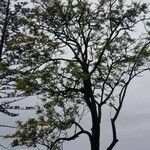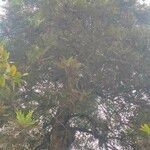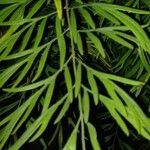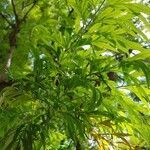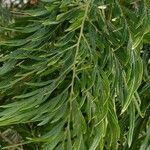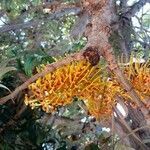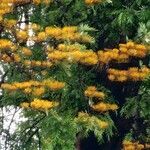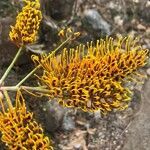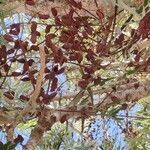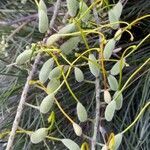Tree to c. 15 m tall, with dark greyish bark. Shoots and lvs reddish brown-tomentose when young, soon becoming grey. Lvs pinnate and fern-like, to c. 30 cm long (including petiole 2-6 cm long); rachis and petiole greyish tomentose with some reddish brown hairs; pinnae (8)-12-c. 20 cm long, deep green and glabrate on upper surface, with greyish white appressed tomentum on lower surface (sparsely hairy and green in juvenile stage), entire and linear to lanceolate or pinnatisect with 1-4 narrow to broadly triangular lobes (narrower in juvenile lvs); apex of entire pinnae and lobes of pinnatisect pinnae acute or mucronate. Infl. a secund, racemose panicle, 10-16 cm long, glabrous except for lower part of rachis. Pedicels 1.3-2 cm long, filiform. Perianth 9-12 mm long, orange or yellow-orange; limb ± ellipsoid, soon revolute under tube. Nectary lobed. Ovary glabrous; stipe c. 3 mm long. Style c. 2 cm long, with a small somewhat oblique cone at apex. Fr. 1.5-2 cm long, very oblique. Seed winged all round.
Tree 8-40 m tall. Leaves 10-34 cm long, 90-150 mm wide, deeply dissected with 11-24 (-31) primary lobes, these entire to 5-partite, sometimes with tertiary division; ultimate lobes oblong to elliptic or subtriangular, 0.5-5 cm long, 2-10 mm wide; margins shortly recurved; lower surface subsericeous to subvillous. Conflorescence erect, terminal, simple to 4-branched; unit conflorescence secund, 12-16 cm long, many-flowered, acropetal. Flowers acroscopic; pedicels 7.5-16 mm long; torus oblique. Flower colour: perianth golden yellow to orange (rarely reddish) outside, inside (partially exposed) with red blotches; style yellow-orange. Perianth glabrous inside and out. Pistil 21-29 mm long, glabrous; ovary stipitate; pollen-presenter erect, shortly conical. Follicle laterally compressed, ellipsoidal to ovoid, 12-16 mm long, glabrous.
A small to large evergreen tree. It grows to 30 m high. It can spread to 4-10 m wide. It is cone shaped. The branches have a brown rusty covering. The leaf stalk is 1.5-7 cm long. The leaves are feather like. There are 7-15 segments and these segments are sword like and 15 mm wide. The leaf blade is 15-25 cm long by 7-15 cm wide. The edges can be curved back. They are silvery on the underside. The flowers occur as masses of long golden yellow blooms. The flower stalk is slender and 1-1.4 cm long. The fruit are boat shaped and 1.5 cm long by 7 mm wide. There are 2 seeds. The seeds are black. They have wings.
Tree up to 30 m. high.. Leaves up to 35 cm. long, pinnate with up to 22 alternate or subopposite pinnae, the pinnae with 1-several linear or linear-oblong acute lobes to deeply pinnatifid or pinnate with up to 16 lobes or pinnules, glabrous above, closely appressed pubescent beneath.. Inflorescence with main axis up to 24 cm. long, usually with several simple lateral branches from near the base, appressed pubescent towards the base but glabrous distally; pedicels 9-15 mm. long, glabrous.. Perianth 7-10 mm., glabrous, bright yellow to orange or reddish.. Fruits ±15 ×10 mm., blackish, glabrous.
Evergreen tree, 18-35 m high, shoots slightly hairy when young, glabrous later. Leaves pinnately divided, 150-300 mm long, dark green above, greyish white beneath, leaflet margins recurved. Inflorescence terminal racemes, 80-150 mm long. Flowers pedicellate; perianth lobes 20-30 mm long, golden-orange. Flowering time Sept.-Nov. Fruit a leathery follicle, brownish black.
A tall tree up to 35 m. Leaves to 300 mm long, green above, with grey, silky hairs below, pinnately divided. Flowerhead a toothbrush-like raceme up to 120 mm long, orange, in clusters on short branchlets. Flowers with a 10 mm long stalk, producing copious nectar. Perianth 6 mm long. Style 20 mm long. Flowers: All year.
Leaves up to 35 cm long, pinnate with up to 22 alternate or subopposite pinnae, the pinnae with 1–several linear or linear-oblong acute lobes to deeply pinnatifid or pinnate with up to 16 lobes or pinnules, glabrous above, closely appressed pubescent beneath.
Inflorescence with main axis up to 24 cm long, usually with several simple lateral branches from near the base, appressed-pubescent towards the base but glabrous distally; pedicels 9–15 mm long, glabrous.
Perianth 7–10 mm long, glabrous, bright yellow to orange or reddish.
Fruits c. 15 × 10 mm, blackish, glabrous.
Tree up to 30 m high.
